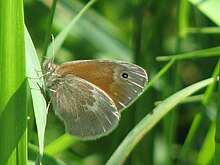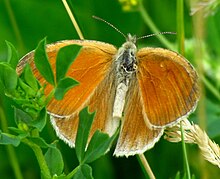Coenonympha tullia
| Coenonympha tullia | |
|---|---|

| |
| Scientific classification | |
| Domain: | Eukaryota |
| Kingdom: | Animalia |
| Phylum: | Arthropoda |
| Class: | Insecta |
| Order: | Lepidoptera |
| Family: | Nymphalidae |
| Genus: | Coenonympha |
| Species: | C. tullia
|
| Binomial name | |
| Coenonympha tullia (Müller, 1764)
| |
Coenonympha tullia, the large heath or common ringlet, is a
Successful reintroductions of the species to North West England took place in 2020, 2022 and 2023.[3]


Description in Seitz
C. tiphon Rott. (— davus F., tullia Hbn.) (48h). Upperside sandy yellow, similar to
Subspecies

- C. t. ampelos (W. H. Edwards, 1871) – northwest common ringlet
- C. t. benjamini (McDunnough, 1928) – prairie ringlet
- C. t. brenda
- C. t. bosniae (Davenport, 1941)
- C. t. columbiana (McDunnough, 1928) – ringlet
- C. t. davus (Fabricius, 1777)
- C. t. elko (W. H. Edwards, 1881)
- C. t. elwesi (Davenport, 1941)
- C. t. eryngii (H. Edwards, 1877)
- C. t. eunomia (Dornfeld, 1967)
- C. t. furcae (Barnes & Benjamin, 1926)
- C. t. gliwa
- C. t. haydenii (W. H. Edwards, 1872) – Hayden's common ringlet
- C. t. inornata (W. H. Edwards, 1861) – inornate common ringlet
- C. t. insulanus (McDunnough, 1928) – Vancouver ringlet
- C. t. kodiak (W. H. Edwards 1869) – Kodiak ringlet
- C. t. mackenziei (D. Davenport, 1936) – Mackenzie's ringlet
- C. t. mcisaaci (dos Passos, 1935) – McIsaac's ringlet
- C. t. mixturata (Alphéraky, 1897)
- C. t. mono (Burdick, 1942) – (common) ringlet
- C. t. ochracea (W. H. Edwards, 1861) – ochre (common) ringlet
- C. t. polydama (Haworth, 1803)
- C. t. pseudobrenda (Austin & R. Gray, 1998)
- C. t. scotica (Staudinger, 1901)
- C. t. sibirica (Davenport, 1941)
- C. t. subfusca (Barnes & Benjamin, 1926)
- C. t. suecica (Hemming, 1936)
- C. t. tullia (Müller, 1764) – common ringlet
- C. t. viluiensis (Ménétriés, 1859)
- C. t. yontocket (Porter & Mattoon, 1989) – Yontocket satyr ringlet
- C. t. yukonensis (W. Holland, 1900) – Yukon common ringlet
Formerly a subspecies:
- Coenonympha nipisiquit (McDunnough, 1939) – maritime ringlet
- Coenonympha california (Westwood, 1851) – California ringlet[7]
For more information on subspecies and biology
Etymology
Named in the
References
- ^ "Large Heath". UK Butterflies. Archived from the original on 4 March 2016.
- ^ a b c Common Ringlet Archived 2013-11-20 at the Wayback Machine, Butterflies of Canada
- ^ "Success for Large Heath reintroduction programme". BirdGuides. 24 June 2023. Retrieved 25 June 2023.
- ^ Seitz. A. in Seitz, A. ed. Band 1: Abt. 1, Die Großschmetterlinge des palaearktischen Faunengebietes, Die palaearktischen Tagfalter, 1909, 379 Seiten, mit 89 kolorierten Tafeln (3470 Figuren)
 This article incorporates text from this source, which is in the public domain.
This article incorporates text from this source, which is in the public domain.
- ^ Savela, Markku. "Coenonympha Hübner, [1819]". Lepidoptera and Some Other Life Forms. Retrieved January 14, 2018.
- ^ Coenonympha, Butterflies of America
- ISSN 2643-4776.
- Emmet, A.M., J. Heath et al. (Ed.), 1990. The Butterflies of Great Britain and Ireland. The Moths and Butterflies of Great Britain and Ireland Vol. 7 Part 1 (Hesperiidae to Nymphalidae). Harley Books, Colchester, UK. 370p.
- Tomlinson, D. & R. Still, 2002. Britain's Butterflies. WildGuides, Old Basing, UK. 192p.
External links
- Coenonympha tullia, ARKive - images and video
- Schmidt, B. C. (April 3, 2003). "Species Details Coenonympha tullia". University of Alberta Museums. E.H. Strickland Entomological Museum. Retrieved November 8, 2020.
- Lepidoptera Pro Russia

